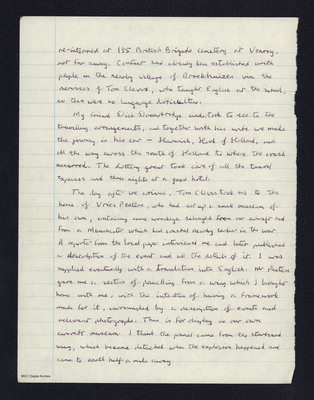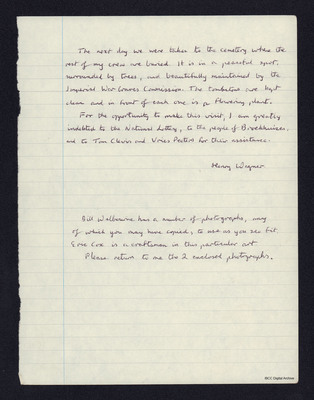Henry Wagner visits the graves of his crew
Title
Henry Wagner visits the graves of his crew
Description
This account was written by Henry for publication in 'The Digger'. Henry recounts that in 2010 he became aware that the National Lottery were awarding grants to veterans to visit places with special memories for them, he applied and was successful. This is the account of his visit to Broekheuzen, Holland, close to where his aircraft had crashed and to the Commonwealth War Graves Commission cemetery.
Creator
Date
2010
Language
Format
Three hand written pages
Publisher
Rights
This content is available under a CC BY-NC 4.0 International license (Creative Commons Attribution-NonCommercial 4.0). It has been published ‘as is’ and may contain inaccuracies or culturally inappropriate references that do not necessarily reflect the official policy or position of the University of Lincoln or the International Bomber Command Centre. For more information, visit https://creativecommons.org/licenses/by-nc/4.0/ and https://ibccdigitalarchive.lincoln.ac.uk/omeka/legal.
Contributor
Identifier
MWagnerHW1604744-170719-160001, MWagnerHW1604744-170719-160002, MWagnerHW1604744-170719-160003
Transcription
[underlined] Item for inclusion in THE DIGGER [/underlined]
Early in 2010 it came to my notice that the National Lottery had a fund called “Heroes Return”, which would provide finance for any ex-service person to the revisit any part of the world in which they had served and had any particular reason to go back to. I applied to go back to the region of Holland where our aircraft crashed in 1944, and to visit the cemetery where the rest of my crew are buried, and was awarded a grant of £875.
The date of the crash was 18 December, and subsequent enquiries I have made revealed that we were shot down by a Junkers 88, by means of upward-firing cannon, flown by Lieutenant Walcher, at a height of some 15,000 feet. With our Halifax on fire, I bailed out, and before anyone else was able to get clear the aircraft exploded, so there were no more survivors. Being the navigator, and therefore knowing where we were, I realised that on a strong N W. wind I was probably going to drift on my parachute across the border and finish up inside Germany, which is in fact what occurred, and after six days on the run I was captured.
The aircraft itself crashed in the far S.E. Corner of Holland, a few miles from the river Maas and the German border, in an area which had only two weeks before been cleared of the retreating Germans and the situation there was far from being back to normal. The rest of my crew were buried temporarily close by the crash site and later
[page break]
re-interned at 185 British Brigade Cemetery at Venray, not far away. Contact had already been established with people in the nearby village of Brockhuizen via the services of Tom Clevis, who taught English at the school, so there were no language difficulties.
My friend Dick Drawbridge undertook to see to the travelling arrangements, and together with his wife we made the journey in his car – Harwich, Hook of Holland, and all the way across the south of Holland to where the crash occurred. The Lottery grant took care of all the travel expensed and three nights at a good hotel.
The day after we arrived, Tom Clevis took us to the home of Vries Peeters, who had set up a small museum of his own, containing some wreckage salvaged from our aircraft and from a Manchester which had crashed nearby earlier in the war. A reporter from the local paper interviewed me and later published a description of the event and all the details of it. I was supplied eventually with a translation into English. Mr Peeters gave me a section of panelling from a wing which I brought home with me, with the intention of having a framework made for it, surrounded by a description of events and relevant photographs. This is for display in our own aircraft museum. I think the panel came from the starboard wing, which became detached when the explosion happened and come to earth half a mile away.
[page break]
The next day we were taken to the cemetery where the rest of my crew are buried. It is in a peaceful spot, surrounded by trees, and beautifully maintained by the Imperial War Graves Commission. The tombstones are kept clean and in front of each one is a flowering plant.
For the opportunity to make this visit, I am greatly indebted to the National Lotter, to the people of Brockhuizen, and to Tom Clevis and Vries Peeters for their assistance.
Henry Wagner.
Bill Welbourne has a number of photographs, any of which you may have copied, to use as you see fit. Eric Cox is a craftsman in this particular art.
Early in 2010 it came to my notice that the National Lottery had a fund called “Heroes Return”, which would provide finance for any ex-service person to the revisit any part of the world in which they had served and had any particular reason to go back to. I applied to go back to the region of Holland where our aircraft crashed in 1944, and to visit the cemetery where the rest of my crew are buried, and was awarded a grant of £875.
The date of the crash was 18 December, and subsequent enquiries I have made revealed that we were shot down by a Junkers 88, by means of upward-firing cannon, flown by Lieutenant Walcher, at a height of some 15,000 feet. With our Halifax on fire, I bailed out, and before anyone else was able to get clear the aircraft exploded, so there were no more survivors. Being the navigator, and therefore knowing where we were, I realised that on a strong N W. wind I was probably going to drift on my parachute across the border and finish up inside Germany, which is in fact what occurred, and after six days on the run I was captured.
The aircraft itself crashed in the far S.E. Corner of Holland, a few miles from the river Maas and the German border, in an area which had only two weeks before been cleared of the retreating Germans and the situation there was far from being back to normal. The rest of my crew were buried temporarily close by the crash site and later
[page break]
re-interned at 185 British Brigade Cemetery at Venray, not far away. Contact had already been established with people in the nearby village of Brockhuizen via the services of Tom Clevis, who taught English at the school, so there were no language difficulties.
My friend Dick Drawbridge undertook to see to the travelling arrangements, and together with his wife we made the journey in his car – Harwich, Hook of Holland, and all the way across the south of Holland to where the crash occurred. The Lottery grant took care of all the travel expensed and three nights at a good hotel.
The day after we arrived, Tom Clevis took us to the home of Vries Peeters, who had set up a small museum of his own, containing some wreckage salvaged from our aircraft and from a Manchester which had crashed nearby earlier in the war. A reporter from the local paper interviewed me and later published a description of the event and all the details of it. I was supplied eventually with a translation into English. Mr Peeters gave me a section of panelling from a wing which I brought home with me, with the intention of having a framework made for it, surrounded by a description of events and relevant photographs. This is for display in our own aircraft museum. I think the panel came from the starboard wing, which became detached when the explosion happened and come to earth half a mile away.
[page break]
The next day we were taken to the cemetery where the rest of my crew are buried. It is in a peaceful spot, surrounded by trees, and beautifully maintained by the Imperial War Graves Commission. The tombstones are kept clean and in front of each one is a flowering plant.
For the opportunity to make this visit, I am greatly indebted to the National Lotter, to the people of Brockhuizen, and to Tom Clevis and Vries Peeters for their assistance.
Henry Wagner.
Bill Welbourne has a number of photographs, any of which you may have copied, to use as you see fit. Eric Cox is a craftsman in this particular art.
Collection
Citation
Henry Wagner, “Henry Wagner visits the graves of his crew,” IBCC Digital Archive, accessed October 29, 2024, https://ibccdigitalarchive.lincoln.ac.uk/omeka/collections/document/30553.
Item Relations
This item has no relations.



